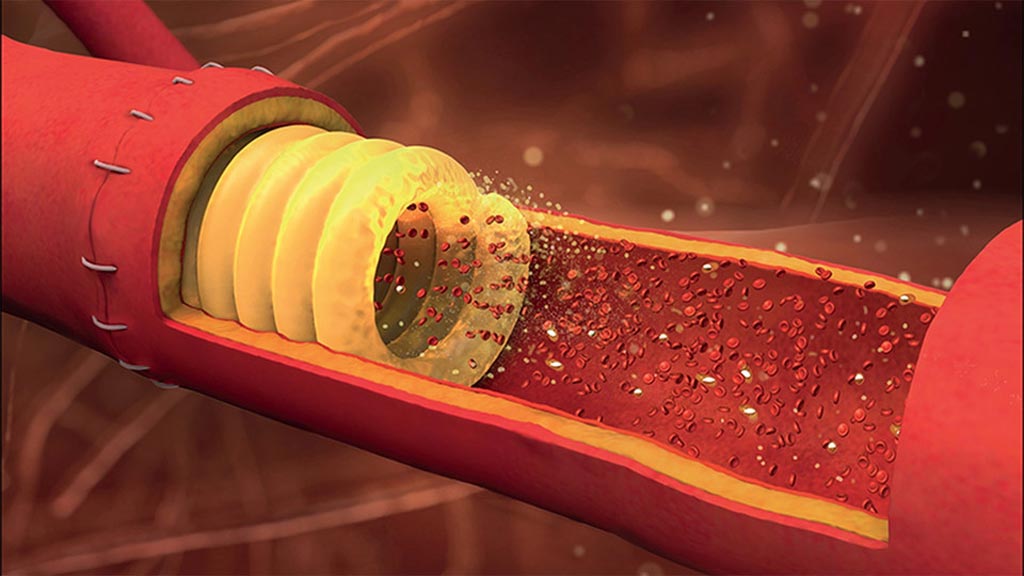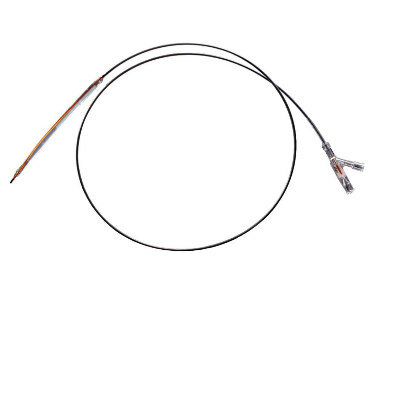Sugar-Based Stents Facilitate Vascular Anastomosis
|
By HospiMedica International staff writers Posted on 30 Jan 2019 |

Image: A spiral-shaped printed stent helps surgeons stich arteries back together (Photo courtesy of UNL).
A new study describes how dissolvable sugar‐based stents can be fabricated using additive printing to help surgeons improve microvascular anastomosis.
Developed by researchers at the University of Nebraska (UNL; Lincoln, USA), Brigham and Women’s Hospital (BWH; Boston, MA, USA), Shiraz University (Iran), and other institutions, the 3D printed, sugar‐based stents are designed to hold the blood vessels together during the anastomosis suturing procedure, dissolving upon restoration of the blood flow. The dissolution rate and the mechanical properties of the dissolvable stents can be tailored between four and eight minutes.
To enable manufacture of stents with desirable geometries and dimensions, the researchers developed a molten sugary ink that is fluid enough to print, but viscous enough to solidify in minutes. Dextran, a glucose derivative, provides the necessary flexibility, so that the stent is not brittle; glucose is used to provide the adhesive properties that bind the stent to the arteries; and a combination of sucrose and sodium citrate help combat blood clotting. Once printed, the sugar-based concoction is baked until most of the water evaporated.
For the study, the researchers experimented with transparent tubing and pig arteries, showing that the stent erodes quickly but steadily when subjected to the flow rate, temperature, and salinity, of human arteries. The suturing held up with no signs of leakage immediately following the surgical procedure. The researchers plan to test the stent's use in live animal arteries, and envision a future in which such stents are printed on site at hospitals within minutes to meet the needs of individual patients. The study was published in the December 2018 issue of Advanced Healthcare Materials.
“The small sugar-based tube fits inside the adjacent ends of a clipped artery. By sticking to the interiors, the stent holds those ends in place and provides structural support during the precarious sewing process,” explained corresponding author mechanical engineer Ali Tamayol, PhD, of UNL. “The stent also reduces the risk of a surgeon mistakenly threading through both the top and bottom walls of an artery, which blocks subsequent blood flow. Sugar is bad; but here we found an application in which it's good.”
Successful microvascular anastomosis depends upon magnification, special instrumentation and fine suture materials, and the surgeon's skill. The key points of one-millimeter vessel anastomosis are the wall-to-wall coaptation of the vessel ends and a low number of interrupted stitches with relatively loose knot. To gain good coaptation, an oblique insertion of a needle through the vessel wall must be used. In a thin-walled vein repair, the lumen should always be kept open with frequent irrigations.
Related Links:
University of Nebraska
Brigham and Women’s Hospital
Shiraz University
Developed by researchers at the University of Nebraska (UNL; Lincoln, USA), Brigham and Women’s Hospital (BWH; Boston, MA, USA), Shiraz University (Iran), and other institutions, the 3D printed, sugar‐based stents are designed to hold the blood vessels together during the anastomosis suturing procedure, dissolving upon restoration of the blood flow. The dissolution rate and the mechanical properties of the dissolvable stents can be tailored between four and eight minutes.
To enable manufacture of stents with desirable geometries and dimensions, the researchers developed a molten sugary ink that is fluid enough to print, but viscous enough to solidify in minutes. Dextran, a glucose derivative, provides the necessary flexibility, so that the stent is not brittle; glucose is used to provide the adhesive properties that bind the stent to the arteries; and a combination of sucrose and sodium citrate help combat blood clotting. Once printed, the sugar-based concoction is baked until most of the water evaporated.
For the study, the researchers experimented with transparent tubing and pig arteries, showing that the stent erodes quickly but steadily when subjected to the flow rate, temperature, and salinity, of human arteries. The suturing held up with no signs of leakage immediately following the surgical procedure. The researchers plan to test the stent's use in live animal arteries, and envision a future in which such stents are printed on site at hospitals within minutes to meet the needs of individual patients. The study was published in the December 2018 issue of Advanced Healthcare Materials.
“The small sugar-based tube fits inside the adjacent ends of a clipped artery. By sticking to the interiors, the stent holds those ends in place and provides structural support during the precarious sewing process,” explained corresponding author mechanical engineer Ali Tamayol, PhD, of UNL. “The stent also reduces the risk of a surgeon mistakenly threading through both the top and bottom walls of an artery, which blocks subsequent blood flow. Sugar is bad; but here we found an application in which it's good.”
Successful microvascular anastomosis depends upon magnification, special instrumentation and fine suture materials, and the surgeon's skill. The key points of one-millimeter vessel anastomosis are the wall-to-wall coaptation of the vessel ends and a low number of interrupted stitches with relatively loose knot. To gain good coaptation, an oblique insertion of a needle through the vessel wall must be used. In a thin-walled vein repair, the lumen should always be kept open with frequent irrigations.
Related Links:
University of Nebraska
Brigham and Women’s Hospital
Shiraz University
Channels
Critical Care
view channel
Light-Based Technology to Measure Brain Blood Flow Could Diagnose Stroke and TBI
Monitoring blood flow in the brain is crucial for diagnosing and treating neurological conditions such as stroke, traumatic brain injury (TBI), and vascular dementia. However, current imaging methods like... Read more
AI Heart Attack Risk Assessment Tool Outperforms Existing Methods
For decades, doctors have relied on standardized scoring systems to assess patients with the most common type of heart attack—non-ST-elevation acute coronary syndrome (NSTE-ACS). The GRACE score, used... Read morePatient Care
view channel
Revolutionary Automatic IV-Line Flushing Device to Enhance Infusion Care
More than 80% of in-hospital patients receive intravenous (IV) therapy. Every dose of IV medicine delivered in a small volume (<250 mL) infusion bag should be followed by subsequent flushing to ensure... Read more
VR Training Tool Combats Contamination of Portable Medical Equipment
Healthcare-associated infections (HAIs) impact one in every 31 patients, cause nearly 100,000 deaths each year, and cost USD 28.4 billion in direct medical expenses. Notably, up to 75% of these infections... Read more
Portable Biosensor Platform to Reduce Hospital-Acquired Infections
Approximately 4 million patients in the European Union acquire healthcare-associated infections (HAIs) or nosocomial infections each year, with around 37,000 deaths directly resulting from these infections,... Read moreFirst-Of-Its-Kind Portable Germicidal Light Technology Disinfects High-Touch Clinical Surfaces in Seconds
Reducing healthcare-acquired infections (HAIs) remains a pressing issue within global healthcare systems. In the United States alone, 1.7 million patients contract HAIs annually, leading to approximately... Read moreHealth IT
view channel
Printable Molecule-Selective Nanoparticles Enable Mass Production of Wearable Biosensors
The future of medicine is likely to focus on the personalization of healthcare—understanding exactly what an individual requires and delivering the appropriate combination of nutrients, metabolites, and... Read moreBusiness
view channel
Philips and Masimo Partner to Advance Patient Monitoring Measurement Technologies
Royal Philips (Amsterdam, Netherlands) and Masimo (Irvine, California, USA) have renewed their multi-year strategic collaboration, combining Philips’ expertise in patient monitoring with Masimo’s noninvasive... Read more
B. Braun Acquires Digital Microsurgery Company True Digital Surgery
The high-end microsurgery market in neurosurgery, spine, and ENT is undergoing a significant transformation. Traditional analog microscopes are giving way to digital exoscopes, which provide improved visualization,... Read more
CMEF 2025 to Promote Holistic and High-Quality Development of Medical and Health Industry
The 92nd China International Medical Equipment Fair (CMEF 2025) Autumn Exhibition is scheduled to be held from September 26 to 29 at the China Import and Export Fair Complex (Canton Fair Complex) in Guangzhou.... Read more














